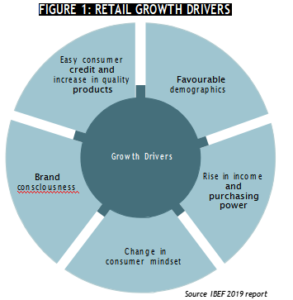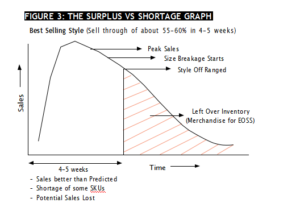Fashion retailing, which includes apparel footwear and accessories, comprises roughly 9 percent of organised retail in India, suggesting the enormous potential for growth in the coming years…
 India’s retail industry remains vibrant, with growth projected from an estimated US$ 672 billion in 2017 to $1,200 billion in 2021 (IBEF Report, Jan 2019) on the back of factors like favourable demographics, rising incomes, a burgeoning middle class and their lifestyle changes.The sector plays a significant role contributing to almost 10 percent of India’s GDP. The story of-course is not without its twists. Organised retail is not more than 9 percent of the total retail market.
India’s retail industry remains vibrant, with growth projected from an estimated US$ 672 billion in 2017 to $1,200 billion in 2021 (IBEF Report, Jan 2019) on the back of factors like favourable demographics, rising incomes, a burgeoning middle class and their lifestyle changes.The sector plays a significant role contributing to almost 10 percent of India’s GDP. The story of-course is not without its twists. Organised retail is not more than 9 percent of the total retail market.
Fashion retailing, which includes apparel footwear and accessories, comprises roughly 9 percent of this organised retail, suggesting the enormous potential for growth in the coming years.
Despite bright growth prospects, the industry faces infrastructural challenges, shortage of skilled manpower, high rentals and the GST implementation challenge. India also remains a heterogeneous market influenced by linguistic, cultural and regional diversity. Leaving aside English and Hindi the country communicates in at least 20 regional languages This necessitates that fashion retailers think of India not as one market but as many diverse sub- markets tweaking their offering to unique local needs.
 Yet another crucial aspect is the fact that over-all India’s retail distribution networks have a long tail. India is spread across 5,500 towns and over 600,000 village. Only 15 percent of the 640 districts are home to over 35 percent of the population with the remaining 65 percent of the population speared over the remaining districts.
Yet another crucial aspect is the fact that over-all India’s retail distribution networks have a long tail. India is spread across 5,500 towns and over 600,000 village. Only 15 percent of the 640 districts are home to over 35 percent of the population with the remaining 65 percent of the population speared over the remaining districts.
The Current Scenario
 India’s major fashion retailers have been implementing the best of management techniques, new age technologies and HR practises. These include best practises in co-location of their new stores, visual merchandising, hiring and training of new staff, introduction of new merchandise, logistics & warehousing and usage of latest software’s for product lifecycle management and ERP solutions. Several retailers have already started intensive use of technology to enhance their operational effectiveness. Future group for example has partnered with a global analytics firm for implementing analytical solutions to reduce stock outs, customer churn and lead time.
India’s major fashion retailers have been implementing the best of management techniques, new age technologies and HR practises. These include best practises in co-location of their new stores, visual merchandising, hiring and training of new staff, introduction of new merchandise, logistics & warehousing and usage of latest software’s for product lifecycle management and ERP solutions. Several retailers have already started intensive use of technology to enhance their operational effectiveness. Future group for example has partnered with a global analytics firm for implementing analytical solutions to reduce stock outs, customer churn and lead time.
The tremendous growth of e-commerce market also plays an integral role in the high scale development of the retail sector. The past decade witnessed an increase in consumer spending, entry of key e-retail players, faster internet speed on reliable telecom networks. By 2020, ecommerce will be a $700 billion market (B2B) with 530 million shoppers by 2025, coming at par with offline stores within a span of five years.
Yet for many retailers it has been a turbulent ride and most continue to face headwinds on 3 major metrics:
- Operational profitability continues to be adversely impacted in most companies
 While newer brands are entering the fray and existing brands are going in for new store expansion, footfalls of customers and sales conversion have not been proportionate resulting in lower inventory turnarounds. This in turn disrupts cash-flow cycles.
While newer brands are entering the fray and existing brands are going in for new store expansion, footfalls of customers and sales conversion have not been proportionate resulting in lower inventory turnarounds. This in turn disrupts cash-flow cycles.- At the same time investments for both new expansion and resultant increase in working capital are increasing. This passive infusion of capital is in many cases, forcing retailers to turn to debt. Despite decent gross profit margins, the associated costs, including that of finance costs, have significantly dented the bottom line. As per the latest financial data in 2016, Reliance Retail’s annual revenue was about `16,000 crores and profits of about `400 crores. Reliance Retail operated 3,383 stores across 679 cities with an area of over 13 million square feet, as of June 30, 2016. Aditya Birla Fashion Retail – ABFRL clocked a combined revenue of `6,060 crore (or $0.84 billion) for FY’16 and a decent EBITDA of `409 crore.
Limitations of Forecasting
While forecasting is a popular and predominant tool, it is not an exact science. Forecasters rely on past sales data, climatic trends, recent fashion trends, economic conditions, psychographic and demographic factors, upcoming festivals and finally their gut feel. Two factors inherent to any forecast are; firstly, there is an ‘error quotient’ assigned to any forecast and secondly as the forecasting horizon increases the forecasting error quotient is likely to increase.
The Retailer’s Challenge
Maintaining Availability & Freshness of Merchandise: At this juncture it is pertinent to look at major challenges faced by fashion retailers. Unlike staple items (like food, grocery etc) where purchase is pre-defined, apparel purchases in most cases are undefined, where customers make broad comparisons in a category before making the final choice. In such cases having the right product (in terms of style, construction, silhouette, colour and size) at the right price is crucial. Thus ‘Availability’ is of essence. ‘Freshness’ the ability to present multiple collections, as seen from the customers perspective also plays a crucial role. A purchase happens only if the above two criterions are met. Conversely for a given product, non-availability and / or non- freshness result in the customer immediately appraising and purchasing competitor’s products. Thus, in fashion retailing ‘customer tolerance time’ is zero as compared to the purchase of certain ‘customer tolerance time’ is zero as compared to the purchase of certain.
 Impact of Increasing Seasons: Availability and freshness both are a function of the retailers supply chain efú cacy. They also remain a function of the number of seasons that retailers build into a retail year. Starting with two six-month periods i.e. Spring-Summer and Fall-Winter, most retailers divide this further into two three-month periods to keep up with the forecasting and ever-changing consumer demands. Leaders such as H&M & Zara are using substantially shorter cycles to keep up with demands of fast fashion.
Impact of Increasing Seasons: Availability and freshness both are a function of the retailers supply chain efú cacy. They also remain a function of the number of seasons that retailers build into a retail year. Starting with two six-month periods i.e. Spring-Summer and Fall-Winter, most retailers divide this further into two three-month periods to keep up with the forecasting and ever-changing consumer demands. Leaders such as H&M & Zara are using substantially shorter cycles to keep up with demands of fast fashion.
Most retailers strive to build an efficient supply chain, primarily, by ordering relatively large volumes to drive down costs with both raw-material sources and manufacturers and transporting by container loads to reduce both freight costs and no of deliveries. In many ways this also necessitates buying earlier in the season leading to dependence on forecasts.

Retailers typically pre-order inventory a few months ahead of the season using forecasting tools. These goods then arrive at the distribution centre, where they are sorted, and 100 percent of the quantity is allocated to respective stores. A few weeks into the season a few styles get sold very fast. These ‘fast movers’ are ‘sold-out’ within the first few weeks, exhausting the quota for the entire season, thus causing a ‘stock-out’. Demand for these fast-mover item persists, yet in most cases the retailer is unable to replenish these styles owing to long manufacturing and transportation lead times and Minimum Order Quantities demanded by manufacturers. This inability to replenish the fast movers represents a ‘tangible opportunity loss’ for the retailers, hindering their ability to achieve targeted sales for the season at original marked-up price. Conversely there are many styles that Best Selling Style (Sell through of about 55-60% in 4-5 weeks) perform poorly compared to their forecasted rate of sale. These ‘slow movers’ not only take up valuable retail space, preventing fresh, new product lines being displayed, but also bloat the working capital and block the open to buy (OTB) limits for the next season.
While EOSS helps to liquidate the excess inventory, it also has negative ramifications in terms of discounted margins as compared to the targeted price. Delays in sales, not only reduce the Open to buy budget of the Category manager, but also lead to delays in realisation of the proceeds. This, in many cases leads to either delay in release of newer collection, or release of lesser no of collections against the originally planned numbers or both.
Most retailers try to work their way out of this quagmire by opening new stores or taking the franchisee route. However, this is even more damaging, demanding substantially more capital, both for opening new stores and buying merchandise to fill these stores. Secondly given that the supply chain modus operandi remains same – each new store faces the same stock out vs surplus conû ict, locking away further capital and putting the company even deeper into vicious circle. Thus, the stock out and surplus conû ict combined with heavy discounts leads the retailer further into lower profitability.
The Direction of Solution
 The above described scenario is essentially a ‘Forecast & Push model’ for supply chain operations. While many retailers assume that this model enables them to ‘leverage their resources’ and create efficient operations, this leads them down a vicious path of lower profitability. It is thus imperative to review the existing framework and question a few commonly followed practises:
The above described scenario is essentially a ‘Forecast & Push model’ for supply chain operations. While many retailers assume that this model enables them to ‘leverage their resources’ and create efficient operations, this leads them down a vicious path of lower profitability. It is thus imperative to review the existing framework and question a few commonly followed practises:
- Is the vendor / manufacturer merely a discrete part in the supply chain -with whom the retailer seeks a price / volume trade-off season to season?
- Does shipping container loads / truckloads of merchandise to the warehouse really save money in the long term?
- Does the practice of not holding any merchandise at the warehouse and shipping it all to the respective stores help accelerate sales?
- What are the alternatives to the current ‘ordering solely based on forecast’ method?
To liquidate these ‘surplus’ goods and prepare themselves for the next season, retailers uses tactics like end-of-season-sales (EOSS).
Some solutions include:
LEAN and Theory of Constraints: The two most successful ‘operation management’ methodologies followed world-wide, LEAN and Theory of Constraints talk of establishing a two-way flow; firstly, the rapid flow of goods from the vendors to the retail showroom, while at the same time continually accessing and feeding-back point of sales data in the reverse direction to the vendors. With reduced lead times, not only are forecasts likely to be more accurate, but also, this enables the supply chain vendors to respond faster to consumer demands. Fundamentally this involves moving away from the ‘Forecast & Push Model’ to the ‘Replenish & Pull Model’. Establishing flow along the entire supply chain should integrally include the following elements.
With reduced lead times, not only are forecasts likely to be more accurate, but also enable supply chain vendors to respond faster to consumer demands.
Seek to Establish Deep Collaborative Relationship with a Core Group of Vendors: Work with vendors, right from inception – through product development and sourcing to help shorten lead times.
- Analysis reveals that the essential raw material (greige goods) for a large variety of styles / lines are common in a given season. These greige goods can be stockpiled in reasonable quantities with costs borne jointly by the retailer and the manufacturer.
- The same principle can also be followed for a commonly used accessories- i.e. packing accessories (such as polybags, tags, etc) and even in the case of Sewing accessories such as interlinings or buttons etc.
- While MOQs (Minimum Order Quantities) do technically matter in manufacturing (both at the fabric & garment stage) customer preferences follow no such logic, leaving the retailer with excess unsold inventory. Hence during buying negotiations, it imperative for retailers to move away from ‘economies of scale’ (having a price versus volume negotiation) to ‘economies of scope’ – implying the need to make a style, multiple times with higher number of changeovers, thereby also acknowledging and paying for a commensurate increase in FOBs.
- This by itself may not be enough. Manufacturers also need to have spare capacity to process Quick-response replenishment orders. This is where buying and retaining minimal capacity with a few core vendors comes in. While this at the outset, sounds counter-intuitive, the ability to quickly replenish fast-sellers shall more than make up for expenses incurred in spare capacity buying.
- The above cumulatively shall enable vendors to quickly respond to calls for replenishment of fast-selling styles / SKUs.
Reconfiguring the Logistics Network: Given the above revised framework of sourcing and manufacturing it is imperative to move away from picking and delivering full tuck / container loads infrequently, to planning and configuring newer networks which are agile, and capable to deliver smaller loads frequently in substantially shorter lead times. While this does per se increase transportation costs, the overall supply chain becomes more responsive, enabling quicker replenishment of fast-moving items, earning greater profits and credibility for the retailer.
 Leverage Central / Regional Warehouses: In most supply chains 100 percent of the ordered merchandise is despatched from the warehouse into the retail network of stores. However, a few weeks into the season – the store reports shortages across some SKU’s and surplus on other’s, leading to the off-ranging of the Fast-movers and discounting of the surplus. There are also many instances where fast-mover SKU’s face a shortage in one store, while being present at other stores in a given region. An inter-store transfer to satisfy customer demand is a cumbersome and expensive process!
Leverage Central / Regional Warehouses: In most supply chains 100 percent of the ordered merchandise is despatched from the warehouse into the retail network of stores. However, a few weeks into the season – the store reports shortages across some SKU’s and surplus on other’s, leading to the off-ranging of the Fast-movers and discounting of the surplus. There are also many instances where fast-mover SKU’s face a shortage in one store, while being present at other stores in a given region. An inter-store transfer to satisfy customer demand is a cumbersome and expensive process!
This is one of the key reasons to supply only a portion of the ordered merchandise to the stores while retaining the other part at a central / regional warehouse. 100 percent of the merchandise is not pushed to the store, rather it is continually replenished as per store sales to the end customer.
In many cases the holding of the inventory at the central / regional warehouse and replenishing stores based on sales to end customers, ensures that merchandise is held at the point of highest forecast accuracy. The ‘principal of aggregation’ is at play here to ensure that the demands from various stores are averaged out at the central / regional warehouse; greatly helping to greatly reduce both stock-outs and surplus. Toyota tried this when it introduced its Hybrid car Primus in USA as they were not sure about the customer response at different regions. Holding the cars in central warehouse and releasing as per the customer demand helped them manage the supply chain effectively while offering customisation.
 Dynamic Buffer Management Methodology: (DBM) is an inventory management system propagated and practised using the buffer management principles of Theory of Constraints introduced by the management guru Dr Eli Goldratt. This method calls for inventory levels to be constantly and dynamically managed on a continual and need for action basis as opposed to the Min-Max based principle where reordering is triggered only on reaching minimum inventory level.
Dynamic Buffer Management Methodology: (DBM) is an inventory management system propagated and practised using the buffer management principles of Theory of Constraints introduced by the management guru Dr Eli Goldratt. This method calls for inventory levels to be constantly and dynamically managed on a continual and need for action basis as opposed to the Min-Max based principle where reordering is triggered only on reaching minimum inventory level.
DBM constantly monitors both changes in demand as well as variability in supply, using an inherently simple method of classifying the Buffer (Inventory at hand) into multiple colour codes (Green, Yellow & Red).
The status of the buffer remains dynamic, being a function of daily consumption and thereby provides replenishment priorities factoring in the rate of consumption as well as the status of the Buffer.
DBM does away with complex statistical formulae and due to its inherent simplicity enables companies to adopt and execute the methodology with minimal training and shorter lead times.
 DBM thus helps management address inventory management and supply chain issues proactively by identifying and highlighting problems earlier. Leading Indian companies such as Tata Westside and Liberty shoes have used DBM and reaped benefits. These include increased availability, lesser inventory, manifold increase in inventory turns, all leading to substantially higher sales.
DBM thus helps management address inventory management and supply chain issues proactively by identifying and highlighting problems earlier. Leading Indian companies such as Tata Westside and Liberty shoes have used DBM and reaped benefits. These include increased availability, lesser inventory, manifold increase in inventory turns, all leading to substantially higher sales.
Thus, it can be said that retailers who move from a rigid forecast and push based production and inventory management model to an agile pull-based replenishment model which reacts dynamically to consumption signals shall be able to ride the crest of this retail boom and reap higher profits.




